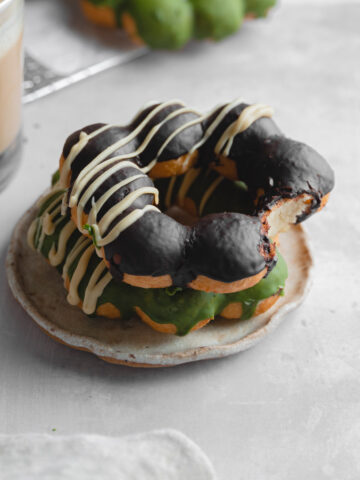Kimchi Jjigae or kimchi stew is one of my favorite Korean foods to eat, no matter what season it is I will never turn down this stew. It’s one of the most-loved of all the stews in Korean Cuisine. Whenever my husband and I watch any Korean drama, this is one of the dishes they feature a lot, and then I start craving it!

This dish is delicious, hearty, quick and easy, very healthy and you only need one pot to cook this! Now don’t be fooled by the vibrant red of this stew, the spice is very mild and you can always adjust the heat to your personal palette. This is an inviting steamy pot of stew and it’s pretty hard to resist when you’re too tired to make anything else.

This stew is loaded with veggies and the fermented kimchi brings the body good probiotics to increase your immunity. Now, with this, you can totally use whatever veggies and other protein you want. I’ve eaten some with mushrooms, broccoli, zucchini, and even rice cakes! My go-to is tofu, zucchini, onion, and of course kimchi.

For this recipe, you only need one pot, which makes it so simple to make. No excuses! Basically all you need to do is dump all the veggies in, cook it until it gets soft, add the water, boil, and add in the jjigae base. Then just let it all cook together to get all the flavors in there and voilà! Serve with rice and enjoy! OH, and don’t worry, you don’t need a traditional Korean cooking pot (dolsot) to cook this in. I just used a large saucepan to cook mine in, although, if you do have one, you’re pretty cool.

Let me know what you think of this recipe in the comments down below! Don’t forget to rate it! You can also share your recreations with me on Instagram, tag me at @flouredframe. Happy cooking!
Flouredframe.com is a participant in the Amazon Services LLC Associates Program, an affiliate advertising program designed to provide a means for sites to earn advertising fees by advertising and linking to Amazon.com.
📖 Recipe

Vegan Kimchi Jjigae (Kimchi Stew)
Equipment
- Cutting board
- Sharp chef knife
- Small mixing bowl
- Medium saucepan
- Ladle
Ingredients
Jjigae Base
- 1 tablespoon Gochugaru (Korean chili flakes (see notes))
- 1 tablespoon Soy sauce
- 1 teaspoon Gochujang (Korean chili paste (optional, if you want it spicy))
- 2 Garlic cloves (minced)
- ¼ teaspoon Black pepper
- 2 teaspoons Mushroom seasoning
Other Ingredients
- 1 tablespoon Sesame oil
- 1 cup Vegan kimchi (I used Nasoya Brand (see notes))
- ½ Onion (diced)
- 1 ¼ cup Water (see notes)
- ½ Block of silken tofu
- ½ of a large zucchini or 1 small zucchini (thinly sliced)
- 1 stalk Green onion (thinly sliced)
Instructions
- Combine the Korean chili flakes, soy sauce, gochujang, garlic, and black pepper in a small mixing bowl and set aside.
- Heat up a large saucepan on medium-high heat, and add the sesame oil. When the oil is hot, add in the kimchi and onions. Cook until the kimchi is soft and the onions are translucent.
- Add the water, and bring it to a boil. Turn down the heat to medium and add in the mushroom seasoning and jjigae base. Continue to mix until the seasonings have dissolved in the water.
- Add the sliced zucchini and silken tofu. Cover the saucepan, and allow it to continue boiling. About 3 minutes.
- When you are ready to serve, pour in a separate bowl and top it off with green onions. Then serve with a side of rice, and enjoy!
Notes
- Gochugaru (Korean chili flakes) - This Korean ingredient differs from American chili flakes. Gochurgaru is coarsely ground Korean chili powder and compared to other chili powders, the texture and taste are very different. I find that it adds more flavor rather than heat. It’s very mild, so don’t skip this ingredient! You can find this and gochujang in your local Asian supermarkets
- Gochujang (Korean spicy paste) - This paste is another ingredient that Koreans use a lot in their kitchen. It is a spicy paste made from red chili peppers, fermented soybeans, rice, and salt. This can be a bit spicy, so taste as you go!
- Substitution for mushroom seasoning - You can use vegetable broth in replacement of the water or 1 teaspoon of vegetable bouillon paste.
- Kimchi - Most kimchi are not vegan and have fish sauce in them, so make sure you read the ingredients. The Nasoya brand is always vegan, so I always use their kimchi.





Leave a Reply